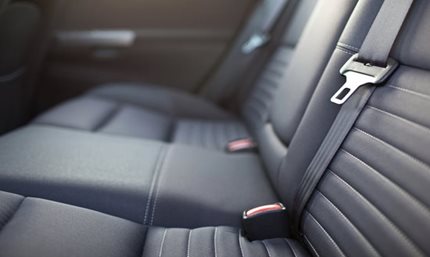News & Tips
Tips for Applying for a Used Car Loan

Buying a used car offers a variety of benefits from saving more money to stressing less about depreciation. Nowadays, you can get a detailed history of the used car, so you have a better idea of what you’re buying. Plus, more information is available online about the reliability of a car’s make and model. While some may find used car financing to be daunting, more and more lenders make it easier than ever. Once you’ve decided to purchase a used car, here are seven steps you can take to streamline the process and help you get the best deal.
#1 Check Your Credit Reports
Lenders look at your credit scores when determining whether or not to approve your used car loan and when deciding the terms to offer you, including used car loan rates. That’s because a credit score helps them to assess how risky it would be to give you a loan — and, the higher your credit scores, the more likely it is that you’ll get the best auto loan rates available.
There are three main credit bureaus that maintain credit reports. Usually, you can get a free copy from each one of them annually. Currently, because of COVID, they’re offering them weekly — meaning, for free. The only place that the federal government authorizes to offer this service is AnnualCreditReport.com. After you receive yours, check for and correct any errors. These reports are what credit score algorithms use to generate the scores that lenders use to assess risk and make loan approval decisions.
If your credit scores aren’t as high as you’d like, you may decide to work on boosting them before applying for a used car loan. Ways to do that include making all of your payments on time, getting credit card balances to where they’re less than 30% of your total available credit; and not applying for other loans in the interim.
#2 Get Pre-Approved for a Used Car Loan
A pre-approval allows you to have a better idea of what your budget is before buying a vehicle, what loan programs you can use, and what your interest rate may be. The lender can determine all of this based on your financial information and credit scores.
This is different from pre-qualification. How? With pre-qualification for a used auto loan, you may gain some useful information about what you can afford and what your potential interest rate and payment could be. But, because this process is simpler and doesn’t involve as much verification by the lender, it provides less certainty for the seller that you’ll be able to secure funding for a vehicle. Pre-qualifying, in essence, is the step before pre-approval.
Here’s another key difference between the two. With pre-qualification, a lender will typically do a “soft” credit pull if they do one at all. A credit check of this type has no impact on your credit scores. However, when getting pre-approved, a “hard” credit check will likely be conducted with at least one credit bureau to get your score and report. This type of check is tracked by credit bureaus, and if you have a high number of these, there is a possibility that your score will be temporarily lower.
SCCU makes getting pre-approved convenient. You can apply online, call 800-447-7228, or stop by your local branch office. Then, you can shop with confidence!
#3 Shop for Used Cars in Depth
Maybe you already know what kind of vehicle you want. If so, visit dealerships that sell this kind of car, and when you find one that interests you, consider the vehicle’s condition, listed price, features, and mileage.
Inspection
Consumer Reports offers detailed guidance on how to inspect a used car, noting how the Federal Trade Commission (FTC) requires dealers to post a detailed guide (usually done via a window sticker) about the vehicle. This includes whether the car will come with a warranty or is sold “as is” and what percentage of repair costs the dealer must pay.
Carefully inspect the exterior and interior of the vehicle; if you’re serious about buying the car and don’t have mechanical expertise, it's a good idea to have a mechanic inspect it before you agree to purchase, including under the vehicle and under the hood. You can typically have this done for $100 to $150.
Used Luxury Cars: In today’s world, many pre-owned cars are in excellent shape with low miles, especially in the luxury market. Many cars in this luxury class can be purchased as a certified car, which extends the new car warranty after a thorough inspection by the mechanic at the dealership. Any issues are repaired before the car can be sold as a certified unit. As a certified car, you can then purchase an extended warranty that continues the warranty past the certification time to meet your driving habits. You will pay extra for the warranty and certification; however, this is highly recommended in the luxury market. This should save you money in the long run if you intend to keep the car for more than a few years. Best of all, it will give you peace of mind.
Test Drive
Take the vehicle for a test drive and leverage info found at places like Carfax and AutoCheck to verify information provided to you by the seller. The biggest question is does this car feel comfortable and react as you anticipated after the test drive? Do not purchase a car that you do not feel comfortable driving. Not all cars feel or drive the same and what feels right for you may not feel right for someone else. That is why there are so many different styles of cars.
Used ar Price Negotiation
Having information from a qualified mechanic can help when you negotiate the price of your vehicle. To provide some context, in the summer of 2020, the average used car cost was $21,558, according to J.D. Power — although, clearly, prices can range significantly based on the vehicle of interest.
#4 Compare Lenders and Used Car Loan Rates
Although dealerships typically offer convenient financing, they don’t necessarily offer the best auto loan rates. Items to look for when deciding where to get financing include:
- Low interest rates for car loans
- Low fees charged
- Good auto loan terms available
- Reasonable down payment required
By law, lenders must provide you with an annual percentage rate (APR), which factors in the interest rate, the fees, and interest that accumulates before the first payment is due. Because all lenders need to use the same formula for an APR, this gives you an apples-to-apples comparison. If the interest rate and APR are numerically close, this indicates low fees. Larger difference? Higher fees. Also, check to ensure that something about the vehicle (perhaps its age) won’t disqualify you from the financial institution’s used car loans.
"I purchased a vehicle very recently and SCCU had the BEST interest rate of all other financial institutions."
Mike V.#5 Gather Necessary Documents
When it’s time to apply for your loan, you’ll need to provide documentation, which includes the purchase agreement for the vehicle plus information about your income (perhaps pay stubs and income tax paperwork); debts, including the lender’s name; your monthly payments and the outstanding balance; and identification.
#6 Fill Out the Used Car Loan Application in Detail
You can fill out an application either online or in person, and the lender can decide whether to approve it — and, if so, under what interest rate and term. The application will have places for you to list your employment information and your income as well as what debts you owe.
You’ll need to list personal information, including your social security number, which is required to get your credit report, and it’s important that you fill out everything completely and accurately. This will streamline the process, reducing the chances that you’ll be asked to provide additional information.
#7 Review the Requirements for the Underwriting Process
After you apply for a loan, a lender goes through the process of underwriting, which means that the financial institution estimates the amount of risk they would take when loaning someone money. Someone with high income, low debt, and great credit scores is less of a risk than someone with lower income, higher debt, and problematic credit scores (with many borrowers falling in between).
Two critical factors of reviewing a loan application include a borrower’s debt to income (DTI) ratio and their credit scores. To calculate your DTI, add up all of your monthly debt payments and then divide them by your gross (pre-tax) monthly income. The result is a ratio, and to meet a lender’s guideline, they’ll want to see that yours doesn’t exceed their maximum.
Let’s say that a lender has a maximum allowance of a 36% DTI. Your monthly income is $5,700, and when you add up your mortgage payment, credit card payments, and new car payment, let’s say that would be $2,000. Divide that total debt amount by the gross monthly income — that’s an LTV of 35.1%, which would fit within those guidelines.
Making a down payment can help reduce the payment for the car you’re purchasing, which would lower your DTI. In some cases, if you’re a bit over the lender’s maximum limit, you can strategically use those dollars to pay off a personal loan, for example, that may have a high monthly payment but a remaining balance that you’re able to pay off.
If the option is available to you, another strategy to lower your DTI is to extend the term of your car loan. This would, however, likely increase the amount of interest paid over the loan’s life.
Lenders will also have a minimum credit score that they’ll want to see. Note that different financial institutions can have additional requirements, including for credit scores, DTIs, employment stability, and so forth. You can learn more about the car loan process here.
Low Interest Rates for Car Loans at Credit Unions
When you’re looking for the best auto loan rates, it can help to check with your local credit union. Because a credit union is owned by its members, not stockholders, interest rates and fees are typically lower than what’s offered at banks. Plus, they usually pay more interest on savings accounts and certificates, and it can be easier to get your loan application approved.
Contact SCCU
When you find your dream car and make your deal, be sure to ask for financing with Space Coast Credit Union. We finance with most Franchise Dealers in our markets, however, if your dealer does not offer financing at SCCU, call Express Services for financing options. Either way, you could receive the same low rate. If you finance at the dealership, it provides you the convenience of one-stop shopping.
Here’s more information about getting a used car loan with us. Any questions? Call the branch nearest you:
- Brevard: 321-752-2222
- Broward: 954-704-5000
- Miami-Dade: 305-882-5000
- All Other Areas: 800-447-7228


















.jpg?width=430&height=257&ext=.jpg)



APR = Annual Percentage Rate
¹CALCULATOR: The information provided by these calculators is intended for illustrative purposes only and is not intended to purport actual user-defined parameters. The default figures shown are hypothetical and may not be applicable to your individual situation. Be sure to consult a financial professional prior to relying on the results.
²TERMS: Terms available up to 84 months for auto loan purchases and auto loan refinances, up to 240 months for boat and RV loan purchases, and up to 72 months for motorcycle loan purchases and are based on your credit quality, vehicle type, model, and year. Our usual credit criteria apply. Your term may be different. Qualified borrowers only.
³RATES: Rates are subject to change. Rates shown are fixed Annual Percentage Rates and are affected by your credit quality, model year, term selected, loan-to-value (LTV), and payment method. Your rate may be different. Qualified borrowers only. Our usual credit criteria apply. You may be asked to furnish a down payment. Rates shown for auto purchases/auto refinances are fixed Annual Percentage Rates for vehicle model years 2025 and newer. Rates shown for motorcycle purchases are fixed Annual Percentage Rates for vehicle model years 2022-2026. Florida loans are subject to Documentary Stamp Tax. The tax amount is not included in the quoted APR.
